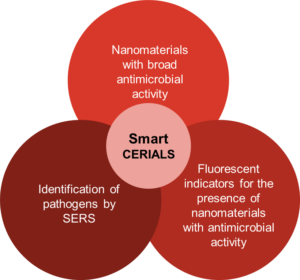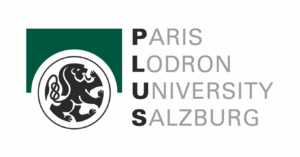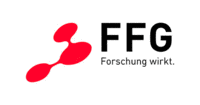SmartCERIALS
Smart CERIum dioxide-based nanocomposites for AntimicrobiaL Surface applications
 The European Centre for Disease Control (ECDC) stated in their “Infographic: Healthcare-associated infections – a threat to patient safety in Europe” form 15 Nov 2018 that 8.9 million people acquire a healthcare-associated infection each year in acute care hospitals and long-term care facilities in the countries of the European Union (EU) and the European Economic Area ( https://www.ecdc.europa.eu/en/publications-data/infographic-healthcare-associated-infections-threat-patient-safety-europe). Further, an estimated 90,000 people in the EU die each year due to the six most common infections in healthcare settings (Cassini et al., 2016, https://doi.org/10.1371/journal.pmed.1002150). This number has been surpassed by far by the current COVID-19 pandemic having rendered door handles, handrails in public transport as major culprits of infection and, in hospitals, personal items such as reading glasses and water bottles were tested positive for virus RNA. Likewise, pathogens such as methicillin-resistant Staphylococcus aureus, respiratory syncytial virus and norovirus can cling to bed rails or hitch a ride from one person to the next on a doctor’s stethoscope. Fast-developing nanotechnologies provide unprecedented opportunities for the increasing demands in the health care sector and elsewhere, in particular in light of the growing antibiotic resistance of bacteria and the current COVID-19 pandemic. Engineered nanomaterials (ENM) possess unique physicochemical properties and an easily functionalizable surface, which can be modified to afford the desired functions. The antimicrobial capacity of some ENM can be further enhanced by appropriate surface modifications and exploited for surface treatment or coating procedures. Due to their unique surface properties (e.g., high surface/volume ratio and activity, surface functionalization capacity, etc.), ENM can bind biological matter with high affinity.
The European Centre for Disease Control (ECDC) stated in their “Infographic: Healthcare-associated infections – a threat to patient safety in Europe” form 15 Nov 2018 that 8.9 million people acquire a healthcare-associated infection each year in acute care hospitals and long-term care facilities in the countries of the European Union (EU) and the European Economic Area ( https://www.ecdc.europa.eu/en/publications-data/infographic-healthcare-associated-infections-threat-patient-safety-europe). Further, an estimated 90,000 people in the EU die each year due to the six most common infections in healthcare settings (Cassini et al., 2016, https://doi.org/10.1371/journal.pmed.1002150). This number has been surpassed by far by the current COVID-19 pandemic having rendered door handles, handrails in public transport as major culprits of infection and, in hospitals, personal items such as reading glasses and water bottles were tested positive for virus RNA. Likewise, pathogens such as methicillin-resistant Staphylococcus aureus, respiratory syncytial virus and norovirus can cling to bed rails or hitch a ride from one person to the next on a doctor’s stethoscope. Fast-developing nanotechnologies provide unprecedented opportunities for the increasing demands in the health care sector and elsewhere, in particular in light of the growing antibiotic resistance of bacteria and the current COVID-19 pandemic. Engineered nanomaterials (ENM) possess unique physicochemical properties and an easily functionalizable surface, which can be modified to afford the desired functions. The antimicrobial capacity of some ENM can be further enhanced by appropriate surface modifications and exploited for surface treatment or coating procedures. Due to their unique surface properties (e.g., high surface/volume ratio and activity, surface functionalization capacity, etc.), ENM can bind biological matter with high affinity.
Based on preliminary results obtained within a previous collaboration, the SIAT-PLUS project partners have strong indication for enhanced antiviral activity of cerium-based ENM and in SmartCERIALS intend to assess their antimicrobial (extending it from antiviral to antibacterial and antifungal efficacy). We thus plan to design and synthesize further Zn- and Ce-based hybrid ENM with (1) enhanced and broad antimicrobial function as raw materials for surface applications. By additive synthesis of gold nanoparticles (Au NP) based upon a green manufacturing route developed by the company partner 4n, we will produce Zn/Ce-based hybrid ENM nanocomposites (NC) and evaluate the feasibility of their smart applications, such as (2) rapid detection of microorganisms using Surface-Enhanced Raman Spectroscopy (SERS) and (3) long-term fluorescence-based coating stability tracing. 4n has also established green synthesis for Cd-free fluorescent nanoprobes as an alternative to quantum dots (QD), which are intended as long-lived detection agents for monitoring the presence of ENM with antimicrobial activity in surface coatings. Combination of different ENM with different properties (in our case antimicrobial activity, detection of bio-nano interactions, and coating stability monitoring), into a multifunctional NC may open new avenues for smart materials in multiple applications related to disease prevention. With the advent of the new EU framework, Horizon Europe, the European Commission has set new priorities. Within the Green Deal there is a demand for cutting-edge clean technological innovation and a globally competitive and resilient industry able to develop products in a safe and sustainable way. Thus, exploring green synthesis for NC development shall greatly expand their commercial application as products of the future.
The partners:


The overall AIM is the green, safe and sustainable development of novel nanocomposite raw materials for smart surface coatings by additive synthesis of different ENM allowing the combination of different desired functionalities. These combined functionalities comprise superior antimicrobial properties that can be used for disinfectant surfaces, the capacity of monitoring microbial binding and deactivation, and include a long-term tracing capacity for assessing coating stability. This complex task shall be achieved by focusing on one R&D objective (1) and conducting two technical application feasibility studies (2 and 3):
- at highest priority we will investigate the possibility of enhancing/broadening the antimicrobial properties (higher affinity for bacterial, fungal, and viral antigens, improved pathogen deactivation) of Ag-free, Zn-/Ce-based ENM by additive synthesis;
- we will evaluate the capacity of in situ monitoring of microbial antigen binding by incorporation of Au NP and the use of SERS;
- and we will evaluate the feasibility to include a fluorescence-based coating stability-tracing feature by integration of Zn-based, Cd-free fluorescent nanoprobes into the NC raw material.
Concomitant with the RTD action, we will (4) pursue method development for green ENM production and (5) conduct comprehensive safety and sustainability assessment in line with the “Green Deal” and the “Safe-and-Sustainable-by-Design” concepts for innovation of advanced materials in the European industrial innovation realm. SmartCERIALS, thus, supports the following Sustainable Development Goals (marked in yellow): 
SmartCERIALS is funded via the Austrian Research Promotion Agency (FFG), grant number 890610: 
…by the Austrian BMK: 
….and the Chinese Academy of Sciences (CAS): 
External advisor is Prof. Victor Puntes from the Catalan Institute of Nanosciences and Nanotechnology (ICN2), Barcelona, ES 





